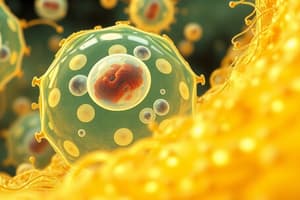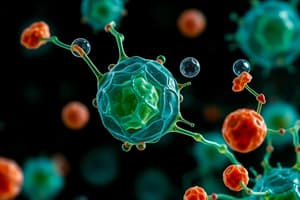Podcast
Questions and Answers
What is the primary role of the cell membrane in cell function?
What is the primary role of the cell membrane in cell function?
- Controlling the movement of materials in and out of the cell (correct)
- Synthesizing proteins within the cell
- Providing energy for cellular activities
- Regulating the cell's shape and structure
Which organelle is present in plant cells but not in animal cells?
Which organelle is present in plant cells but not in animal cells?
- Chloroplast, Lysosome (correct)
- Vacuole, Lysosome
- Golgi Apparatus, Endoplasmic Reticulum
- Chloroplast, Ribosome
What is the function of the vacuole in a plant cell?
What is the function of the vacuole in a plant cell?
- Storage of water, sugars, and ions (correct)
- Protein modification and packaging
- Synthesis of lipids and steroids
- Breakdown of cellular waste and debris
Which type of transport involves movement of materials without the need for energy?
Which type of transport involves movement of materials without the need for energy?
Which state of matter has irregular arrangement and very far apart particles?
Which state of matter has irregular arrangement and very far apart particles?
In which form of passive transport do materials move without the need of energy?
In which form of passive transport do materials move without the need of energy?
In which process do water molecules move from a region of higher water concentration to a region of lower water concentration through a selectively permeable membrane?
In which process do water molecules move from a region of higher water concentration to a region of lower water concentration through a selectively permeable membrane?
Which process involves proteins providing a pathway for large molecules to diffuse into the cell?
Which process involves proteins providing a pathway for large molecules to diffuse into the cell?
Which type of transport requires cells to use up energy to move molecules across the cell membrane against the natural concentration gradient?
Which type of transport requires cells to use up energy to move molecules across the cell membrane against the natural concentration gradient?
3
3
What is the movement of molecules from a region of higher concentration to a region of lower concentration called?
What is the movement of molecules from a region of higher concentration to a region of lower concentration called?
In which process do water molecules move from a region of higher water concentration to a region of lower water concentration through a selectively permeable membrane?
In which process do water molecules move from a region of higher water concentration to a region of lower water concentration through a selectively permeable membrane?
Which process involves proteins providing a pathway for large molecules to diffuse into the cell?
Which process involves proteins providing a pathway for large molecules to diffuse into the cell?
Which type of transport requires cells to use up energy to move molecules across the cell membrane against the natural concentration gradient?
Which type of transport requires cells to use up energy to move molecules across the cell membrane against the natural concentration gradient?
What are the 4 functions of cell division?
What are the 4 functions of cell division?
Which structures in the cell help it to reproduce?
Which structures in the cell help it to reproduce?
What is active transport and the forms of passive transport?
What is active transport and the forms of passive transport?
What is passive transport and the forms of active transport?
What is passive transport and the forms of active transport?
Why do cells divide?
Why do cells divide?
Flashcards are hidden until you start studying
Study Notes
Cell Membrane and Transport
- The cell membrane primarily regulates what enters and exits the cell, maintaining homeostasis and protecting cellular integrity.
- Passive transport does not require energy for the movement of materials across the cell membrane.
- Diffusion is the movement of molecules from a region of higher concentration to a region of lower concentration.
- Osmosis is a specific type of passive transport where water molecules move through a selectively permeable membrane from a higher water concentration to a lower water concentration.
- Facilitated diffusion involves proteins providing pathways for large molecules to diffuse into the cell without energy input.
- Active transport requires energy to move molecules against their natural concentration gradient.
Organelles in Plant vs. Animal Cells
- The chloroplast is an organelle found in plant cells that is absent in animal cells, responsible for photosynthesis.
- The vacuole in a plant cell stores substances, maintains turgor pressure, and plays a role in metabolism and storage.
Types of Transport
- Active transport moves substances across the membrane against the concentration gradient, using cellular energy, often through ATP.
- Passive transport methods include diffusion and facilitated diffusion, both requiring no energy.
Cell Division
- Cell division serves four main functions: growth, repair, reproduction, and maintaining genetic integrity.
- Structures essential for cell reproduction include the nucleus, centrioles, and spindle fibers.
Summary of Processes
- Osmosis encompasses water movement across membranes; diffusion refers to solute movement influenced by concentration gradients.
- Energy is vital for active transport but not for passive transport mechanisms.
Studying That Suits You
Use AI to generate personalized quizzes and flashcards to suit your learning preferences.




